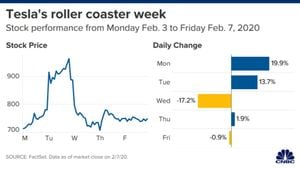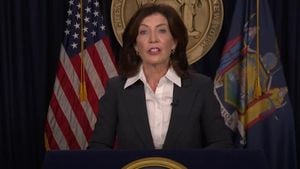The 2024 U.S. presidential election has turned out to be more than just another contest between candidates; it’s become emblematic of the deep divisions within American society. With the scene set for the ultimate showdown between former President Donald Trump and current Vice President Kamala Harris, the stakes couldn't be higher. Both candidates represent starkly different visions for the country, reflecting the complex political and social fabric of the United States.
On the one hand, Donald Trump, who was once impeached twice during his presidency, is back with renewed vigor after winning the election. Demonstrations of his enduring popularity were evident as he garnered significant support, particularly among younger voters and university students, who, traditionally leaning Democratic, appeared to have shifted some of their allegiance toward him this time around. Many young voters cited economic issues, immigration, and national security as pivotal factors influencing their choice.
Griffin Geiken, a junior at the University of Wisconsin-La Crosse, cast his first presidential ballot for Trump, emphasizing economic concerns as his primary motivator. "I am concerned about my ability to build a life after graduation when everything is so expensive," Geiken remarked, echoing sentiments shared by other students who felt economic pressure deeply.
While Trump was busy solidifying his base, appearing determined to tackle issues head-on, the Democrat camp faced challenges of its own. Kamala Harris, aiming to become the first woman and first South Asian president, heightened efforts to connect with youth and minority voters, but reports suggest the effectiveness of her campaigns was lukewarm. Young Democratic voters expressed anxieties surrounding the election results, with reactions like those from UW-Green Bay student Karime Galaviz, who tearfully reflected on her disappointment with Trump’s comeback, indicating extensive worries about the future.
Election night results brought mixed feelings across college campuses. Even though Harris maintained support among the majority of students, her failure to resonate strongly with young men was cited as detrimental. UW-Oshkosh senior Chris Parish noted, "I guess the way the election was going, I just had this feeling Democrats didn’t get the reach they needed to," implying the Democratic campaign's weaknesses around pivotal voter demographics.
On the larger stage of the electoral process, the U.S. employs an indirect election system known as the Electoral College, laid down following centuries of evolution. This mechanism enables candidates to attain the presidency without necessarily winning the popular vote nationwide. Each state’s share of the total 538 electoral votes tip the balance, with 270 needed for victory. This contrasts sharply with systems elsewhere, such as India, where candidates are chosen directly by parliamentary vote.
Leading up to the election, various issues posed challenges. Public discourse centered largely on the economy, heightened violent crime, and immigration; recent studies indicated these sentiments flowed largely from public dissatisfaction with Harris’s leadership and general governance issues surrounding economic stability. Issues like immigration took precedence, especially with nearly 61% of voters indicating it was their primary concern. Harris focused on enhancing border security and addressing transnational crime, positioning her campaign responses against Trump’s more aggressive military-dominated immigration policy.
The world of polling provided additional layers of complexity surrounding perceptions of candidate viability. Voter surveys indicated Trump consistently held advantages over Harris on handling national defense, terrorism, and general foreign affairs, showcasing the electorate’s trust issues surrounding Harris's capability. This trend, as noted by political analysis, isn’t just about choosing between two candidates but reflects broader societal values questioning governmental efficiency.
Add to this mix the heat of foreign relations debates floating around. Trump touted his ‘America First’ doctrine, embracing isolationism coupled with decreased international commitments, which struck chords with voters weary of prolonged overseas entanglements, particularly following the withdrawal from Afghanistan. Harris, to counter, supported strategic global partnerships but struggled to shift voter opinion significantly. Pre-election polling highlighted serious discontent among Americans about the U.S.'s global standing, making this debate timely yet precarious.
Different generations are undoubtedly impacted by these discussions. While older voters might appreciate Trump's experience, younger generations are more jittery about potential rollbacks on women's rights and social issues. Harris's stance on abortion—the recent shifting legality surrounding Roe v. Wade—was spotlighted heavily, leading to grassroots movements rallying around her campaign but still faced resistance within some demographics.
A pivotal moment arose between the candidates during pivotal debates—Trump presenting himself as the “strong leader,” evoking traits associated with historical figures like Ronald Reagan, who promised “peace through strength.” The perception of Trump as capable of military success and strong defense rumors loomed large, perpetuating fears of war around global issues like the Russia-Ukraine conflict or Gaza tensions.
But what can we interpret from this recent election fiasco? Although the votes were cast and counted, they ushered responses from both sides pondering on lessons to learn for the future. Trump’s leadership style resonates with many Americans, echoing themes of strength and personal responsibility, yet Harris’s team needs to capture more effective messaging about their competencies for future elections.
While the election results have entered the history books, the continuous challenge remains for both parties to rebuild and reinforce pathways to voters, especially younger ones, ensuring future electoral success hinges not only on policies but the manner of their delivery. The threads of this election are woven intricately with societal values and internal party dynamics, setting the stage for the upcoming electoral battles.
With the conclusion of this election, many voters linger on the memories of this intense competition as they ponder the political direction of the country under Trump or the legacies built by Harris. What is clear is the road to 2028 already starts, with both political factions needing to regroup, rally voters around their principles, and address the real issues concerning everyday Americans.



